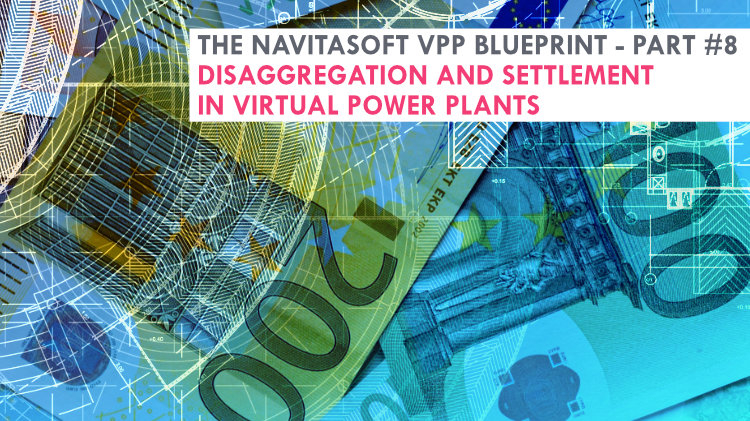
By aggregating and optimizing the operations of small-scale energy sources, VPPs can create a sizable pool to participate in energy markets and deliver grid services. However, effectively managing the real-time coordination and settlement of potentially thousands of heterogeneous DERs remains a significant challenge.
Unlike a traditional power plant, a VPP has no single coherent asset to dispatch. Instead, it must determine the optimal mix of activations across its entire portfolio of Distributed Energy Resources (DERs) to meet flexibility requirements in a safe, reliable, and cost-effective manner.
Developing robust methodologies for disaggregating flexibility needs and dispatch instructions to the individual asset level is not so easy. The DERs that make up a VPP can have vastly different characteristics in terms of costs, operating constraints, ramp rates, efficiency curves, and emissions profiles. Failing to account for these factors properly can lead to suboptimal operations and economic inefficiency.
Furthermore, calculating compensation for DER owners fairly, transparently, and auditable is only the next big challenge. Since a VPP's revenue streams derive from aggregating the capabilities of many individual assets, it must have methods to measure each resource's real-time performance accurately, verify whether it followed dispatch instructions, and distribute payments equitably based on delivered services.
Establishing such disaggregation and settlement mechanisms is an immense operational challenge as VPPs scale up their portfolios and provide increasing flexibility services to the grid. Both technical approaches and market rules must evolve to handle this complexity. This part #8 of our VPP Blueprint series explores the latest practices in these key areas.
Disaggregation refers to distributing flexibility activations or power supply obligations across the individual distributed energy resources (DERs) that comprise a virtual power plant's portfolio. Several approaches exist, ranging from simple solutions to sophisticated economic optimization methods.
Simple Approaches
One of the simplest disaggregation methods is activating DERs by number rather than economics. For example, a VPP operator whose portfolio contains assets owned by multiple third parties could activate an equal number from each owner when flexibility is needed. While straightforward, this method fails to prioritize lower-cost assets and minimize the VPP's overall operating costs.
Simple approaches based on equity rather than economics have significant limitations. They don't account for differences in operational costs, efficiency curves, emissions rates, or other characteristics across the asset portfolio. As a result, they can lead to suboptimal economic dispatch and higher costs for providing flexibility services.
Economic Approaches
A more economically grounded approach uses an internal merit order list to rank assets from lowest to highest operating cost, then activate them sequentially until sufficient flexibility is provided. Determining the merit order involves calculating short-run marginal costs that consider start costs, no-load costs, fuel costs, efficiency curves, emissions costs, and minimum operating limits.
Even more advanced is a dynamic optimization approach that directly accounts for asset characteristics, market conditions like energy prices, and operational constraints like ramping limits. This involves formulating disaggregation as an optimization problem to minimize the cost of meeting a flexibility requirement.
Asset Characteristics and Market Conditions
Multi-period optimization models can capture complex characteristics like start-up costs, non-convex energy curves, emission limits, and operating constraints on DERs. This ensures the co-optimization of operations across the diverse asset portfolio. The model can optimally arbitrage between dispatching the DERs for Ancillary Services and Wholesale Services, or withholding their dispatch, by incorporating the opportunity costs reflected in the day-ahead and real-time market price forecasts.
Methods like mixed-integer linear/non-linear programming are commonly used to solve the resulting optimization problems, which may be implemented in a rolling horizon approach. This allows frequent updating as forecasts change.
While simple approaches offer ease of implementation, there is no way around economic optimization for VPPs to maximize value streams from their DER portfolios. Increasing computational capabilities and advanced algorithms enable more VPPs to adopt sophisticated disaggregation methods. However, practical challenges like forecasting, computing time, and adaptability to changes must still be navigated.
Physical Settlement
Verifying the real-time performance of each individual DER against its dispatch instructions is a key component for VPPs, as this physical settlement data provides the basis for calculating asset owners' compensation.
While VPPs can monitor their aggregate portfolio telemetry, they need visibility into how well each DER responded to its specific setpoint signal or schedule. If a particular asset significantly underperforms, it impacts the overall delivery and payment for flexibility services. Accurate performance data is required to allocate payments and penalties properly.
However, most smaller-scale DERs, such as residential batteries, electric vehicles, smart thermostats, etc., lack the robust metering and communications capabilities of large power plants. Installing utility-grade meters on these resources would be cost-prohibitive. Even with some telemetry, assessing the performance of flexible loads like HVAC or water heaters can be difficult.
As a result, VPPs must develop creative techniques to estimate the real-time operations of DERs in their portfolios:
- Meter Data Analytics: Using advanced statistical and machine learning methods on whatever meter data is available, even low-resolution smart meter readings, to estimate operating parameters and disaggregate composite signals.
- Device-Level Monitoring: Leveraging IoT connectivity and sensors installed at the DER device level to provide detailed temporal data on operations that can be transmitted to the VPP operator.
- Portfolio Telemetry Comparisons: Comparing the aggregate real-time telemetry for the entire VPP portfolio to the aggregate dispatch signal, then using that error residual to infer potential underperformance - this approach requires further investigation.
- Hybrid Approaches: Combining multiple methods, such as portfolio comparisons to identify potential issues, then drilling down with device monitoring and meter analytics.
Once real-time performance data is collected, techniques like dynamic baselining and regression analysis can quantify the flexibility services delivered by each DER relative to its expected operating profile absent an activation. This measured delivery provides the basis for financial settlement payments.
Financial Settlement
With performance data verified through the above methods, VPPs can calculate financial payments to settle with DER owners. The basis for payments may be each asset's measured flexibility, the capacity made available for activations, or a blended approach utilizing both metrics.
Payments must incorporate penalties for resources that failed to perform as instructed. Given the potentially high transaction volumes involved, VPPs typically net amounts owed between asset owners internally before making external payments. Any revenue received from grid services is distributed to owners per their contribution, minus the VPP's share.
Establishing equitable and auditable settlement mechanisms for the distributed, behind-the-meter DER owners enabling VPP operations is essential but extremely challenging. Innovative methods combining technology, economic theory, and new policies and regulations are needed to build trust and ensure fair compensation while providing transparent, automated processes with secure audit trails.
For services with stringent real-time requirements like frequency regulation, dedicated on-site metering and settlement calculations may be required before compensating assets. For example, in Great Britain's Dynamic Containment program, assets must have metering at 20Hz resolution to measure delivered power 20 times per second. Settlement is then based on calculating a "k-factor," indicating if performance met requirements over a 4-hour window.
This is why industry groups are now collaborating on efforts to establish common data standards, process methodologies, business rules, and certification frameworks for VPP settlements.
Emerging Standards and Platforms
Asset owners need confidence that settlements accurately reflect their contributions and that any non-performance is handled fairly per agreed rules. However, manually processing meter data, performance calculations, and financial transactions is impractical at such scales. Automation of settlements with rigorous audit trails and permanent records is necessary for efficient, trustworthy operations.
Recognizing these needs, industry groups are working to establish common standards for VPP settlements. Distribution grid operators, aggregators, DER manufacturers, and technology providers are collaborating on efforts like:
- Data standards and taxonomies for metering, telemetry, and settlement inputs/outputs
- Process and calculation methodologies for verifying flexibility delivery
- Business process standards covering transactions, payments, and audit requirements
- Testing and certification frameworks to ensure interoperability
- While still in relatively early stages, such standards can enable Settlement-as-a-Service offerings, promote competition, and allow assets to participate in multiple VPPs.
In parallel, technology startups are introducing cloud-based settlement automation platforms for VPPs. These solutions ingest operational data, apply configurable business rules and calculation engines, and automate the entire settlement lifecycle - from verification to payment distribution to audit logs.
The most robust offerings utilize distributed ledger technologies to create immutable, cryptographically secure records. This allows for resolving settlement disputes through transparent data sharing rather than error-prone manual processes.
Conclusion
Effective settlement mechanisms that equitably compensate asset owners while accurately reflecting their delivered services are vital for virtual power plants. VPPs require these capabilities to build trust, ensure reliable operations, and fully monetize the flexibility their portfolios provide the grid.
However, settlement practices and technologies are rapidly evolving within this new and growing industry. Aggregating multi-asset-class DERs, verifying their performance, and automating settlement calculations with proper accounting for constraints is an immense technical challenge. Close collaboration between utilities, grid operators, aggregators, OEMs, and technology providers will be essential.
Over time, standardized approaches, certified platforms, and mechanisms enabling full transparency and auditability will emerge. This will enhance confidence in VPP operations, remove barriers to DER adoption, and help virtual power plants reach their full potential as enablers of grid flexibility and renewable integration. While complex, overcoming these settlement hurdles will be a significant success in establishing a more distributed, decarbonized, and resilient electricity system.
The Navitasoft VPP Blueprint
Follow our complete series on VPPs and the digital solutions needed to run them:
Part 1: Forecasting in virtual power plants
Part 2: Integrating virtual power plants
Part 3: Internal system integration and reporting
Part 4: Optimization in Virtual Power Plants
Part 5: Trading Strategies to Optimize Your VPP
Part 6: How to Manage Risk for Your Virtual Power Plant
Part 7: Dispatching & control of execution in virtual power plants
Part 8: Disaggregation and settlement in virtual power plants
Part 9: VPP 3.0 - The Third Generation of Virtual Power Plants




